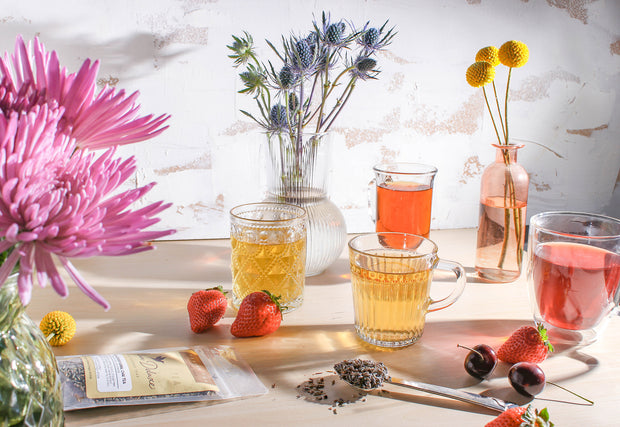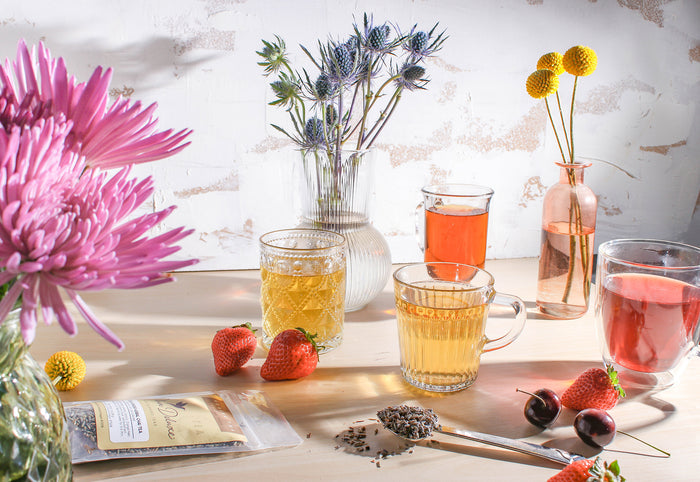All About Herbal Tea
All About Herbal Tea
When people think about tea, it is most commonly associated with caffeinated black or green teas. While herbal teas, more formally known as tisanes, don't include any leaves from the tea plant Camellia sinensis, they are still considered a type of tea.
With all of the different flavor options, caffeine free herbal tea makes the perfect soothing drink to warm you up without the stimulation of traditional tea. Herbal teas also boast many health benefits. There are so many different blends to try, there truly is something for every palate. In this herbal tea guide, I will help you decipher the different types of herbal tea and reach for a blend beyond your usual tried and true cuppa.

Herbal teas are blended in almost limitless combinations, but the individual herbs themselves tend to fall into five categories: fruit, bush, flower, leaves, and spices. Each category has its own brewing behavior and flavor. You can choose your blends based on flavor preference, health benefit, or to try something new!
Fruit
Fruit teas are probably the most popular of the herbals. Just like the name implies, they are flavored with different dried fruits. These blends are often naturally sweet and familiar, like Spicy Caramel Apple Cinnamon Herbal Blend, or can be a bit more adventurous like Self Care Blend, which showcases elderberry and apricot.
Fruit is an ingredient that is forgiving of steep times. You can steep these teas for 5 minutes or longer in boiling water. Fruit teas are likely the easiest place to start for an herbal tea novice – or for a more experienced tea drinker wanting to try something out of their comfort zone.
Bush Tea
One of my favorite brews, rooibos, comes from a bush in South Africa. It is also often called “red tea” or “bush tea” and is a close relative to the honeybush. Both teas are relatively new to the modern tea world. Rooibos and honeybush brew an amber colored tea that tastes earthy, smooth, and lightly sweet, with honeybush being a bit sweeter. There is also a more delicate green rooibos, which doesn’t undergo the oxidation that red rooibos does.
Red tea has a full mouthfeel and holds up well to milk and sweetener, so it has replaced my morning mug of milky black tea as a caffeine free herbal option. If you aren’t familiar with rooibos and want to give it a try, I suggest starting with the simple and classic pairing of vanilla and rooibos. Or, if you want a more complex blend, my two favorites are Pears and Cinnamon and the White Chocolate Peppermint.
Rooibos is hearty. I find it can’t be oversteeped; however, you must consider the other herbs in a blend. Recommended steeping for rooibos is around 5 minutes in boiling water. It is always best to follow the package instructions first, and then play around with times and amounts.
Floral
Floral teas make me think of calming herbal blends to drink before bedtime, but they are certainly delicious and soothing any time of day. Some flowers that are most often used in tea blends are lavender, chamomile, hibiscus, and elderflower.
When flowers are steeped, they let off a perfumed scent and a light, flowery taste. Hibiscus is the exception, as the stamen of the plant that is used is as tart as a lemon. Be careful not to oversteep floral blends unless you are aiming for a strong infusion, as flowers can get very bitter if left in too long. I would start with a 3-minute steep time in just-before-boiling water, and adjust to taste from there.
For lovely floral herbal teas, I suggest Slowly Unwind, which has linden and elderflower but skips on the sometimes perfumed taste of flowers; Easy Like Sunday Morning for a chocolate lavender treat; Calm Chamomile Bloom, which packs in the three flowers of lavender, rose, and chamomile; or Tranquil Peach for a gentle fruit and chamomile blend. Whichever blend you choose, all floral teas are best enjoyed slowly from your favorite china cup.
Leaves
This category encompasses a lot of plants, from the familiar mint to the more exotic tulsi and lemongrass. The flavors of leaves can range anywhere from sweet to refreshing to tingly to zesty to bitter to spicy – it all depends so much on the plant’s constitution and your tastes. This is a good category to experiment with. Pick a flavor you know you enjoy and find a blend that gets creative with it.
Herbal blends based on leaves should be brewed for 3-5 minutes in boiling water and adjusted to taste. Daily Love, a blend of tulsi and sea buckthorn berry with fruit essences, and Best Friend's Advice, a blend of St. John’s Wort, lemon balm, and mango, are both very unique blends with familiar flavors.
Spices
This section is for the plant parts that call for a longer steep time or decoction, including roots, seeds, and bark. These herbs are often used in warming, spiced teas as well as teas for when you are under the weather. The chai spices – ginger (root), cinnamon (bark), fennel (seed), and cardamom (seed) – are good examples.
My favorite spiced teas from Plum Deluxe are the sweet Vanilla Sugar Cookie Dessert Tea with fennel and spices and the autumn seasonal Spicy Caramel Apple Cinnamon Tea. They also have a great selection of chai. The seasonal, herbal blend is the rooibos option of Autumn Chai. Recommended steeping time is generally 4-6 minutes, but can be steeped longer for more warming spiciness.
* * * * *
Herbals have so many flavors and moods to them, so don’t be afraid to try something new or even something you wouldn’t normally consider trying. You could surprise yourself with a new favorite. Plum Deluxe offers a tea tasting flight of three sample teas for $5 that is a wonderful way to try new teas before committing to a full-sized bag. If you are feeling more dedicated, you could sign up for the herbal tea of the month club and try a new, unique herbal blend every month.
Using this herbal tea guide, you could determine which flavor combinations you enjoy best as you try each tea. You could also get some individual ingredients, such as ginger, elderflower, and hibiscus and try blending your own tea flavors.
You don’t need to use your tea leaves with your tea pot, either. There are so many different ways to enjoy loose leaf tea, such as cold brew, sangria, soup, baths, baking, and more. Whatever you choose, I hope you can use these herbal tea moments to slow down.
article and photos by Mary Hadzimichalis
Back to "Learn"












